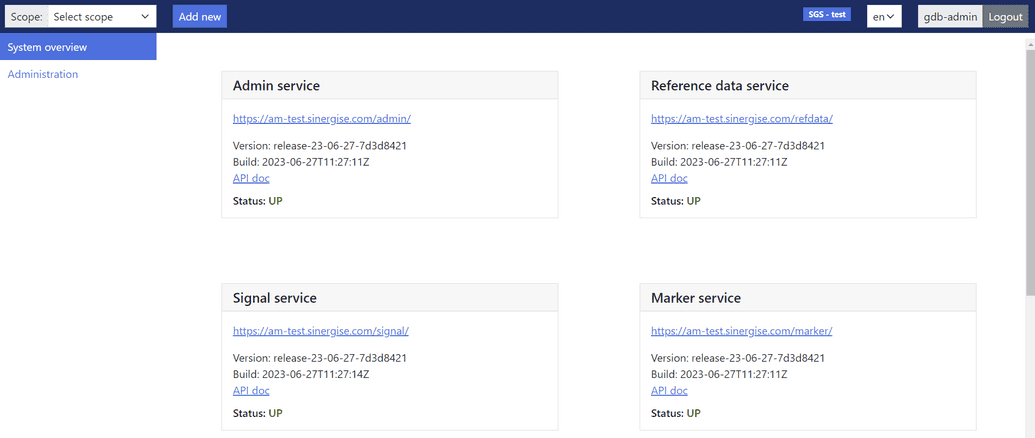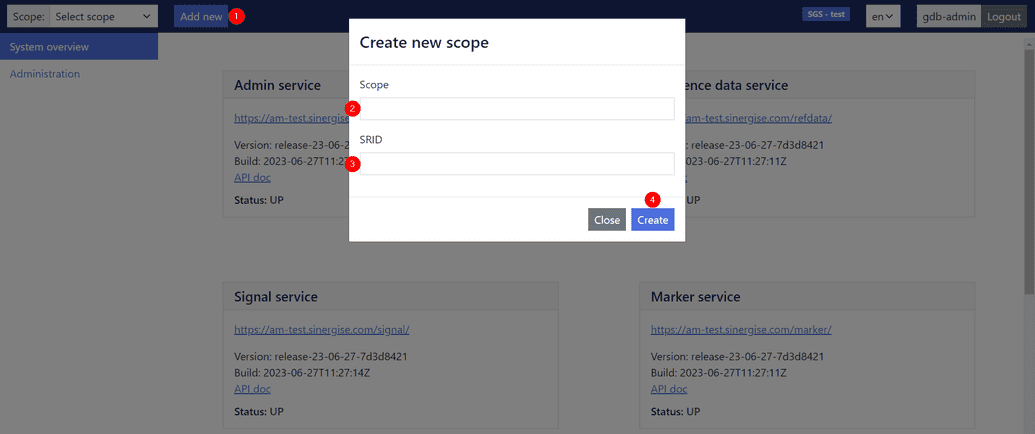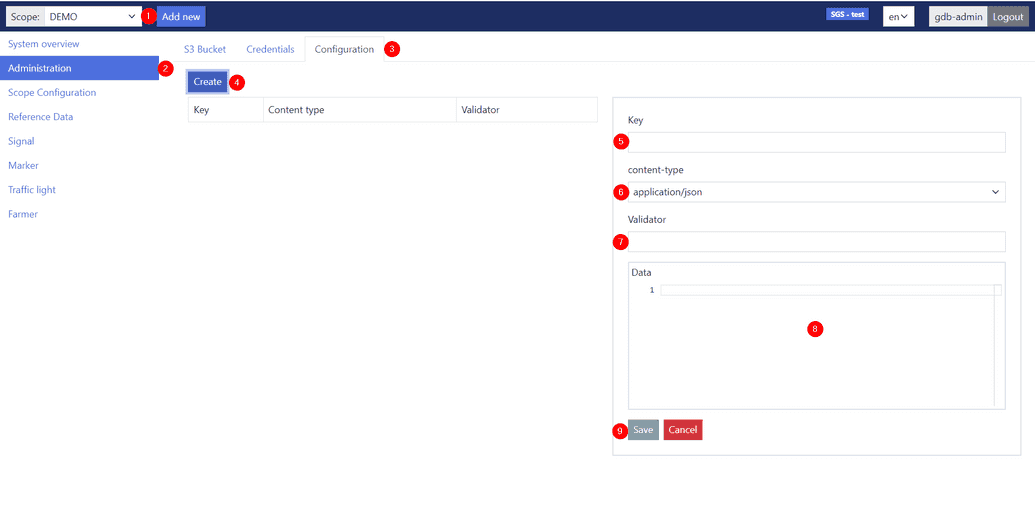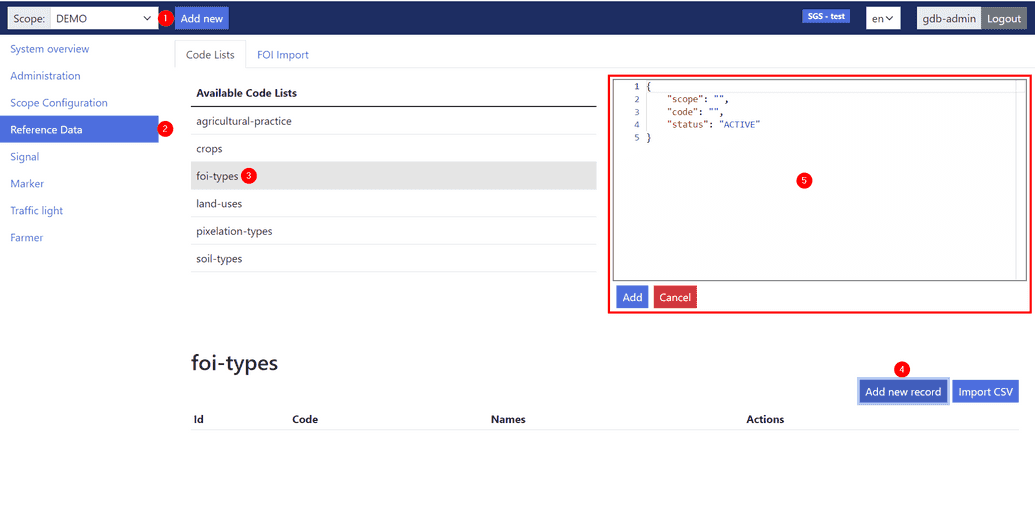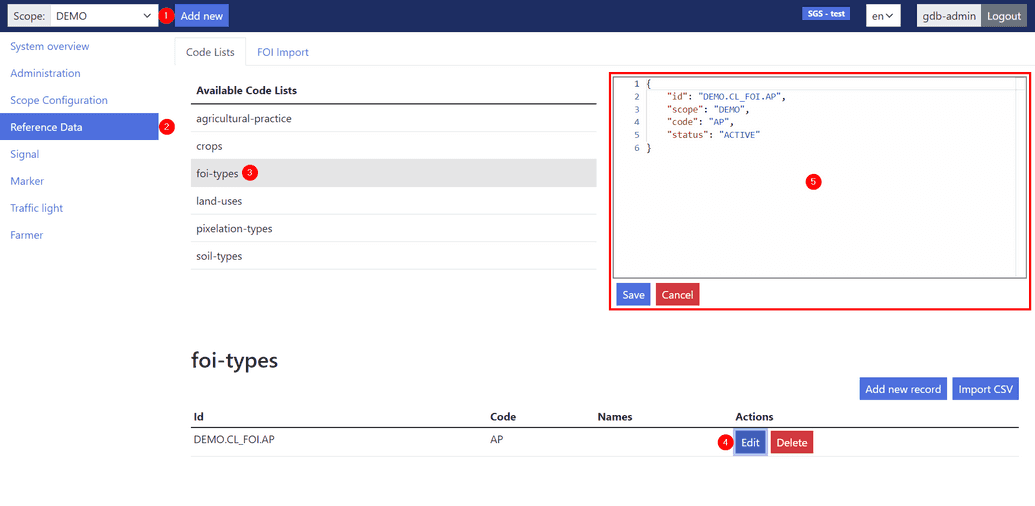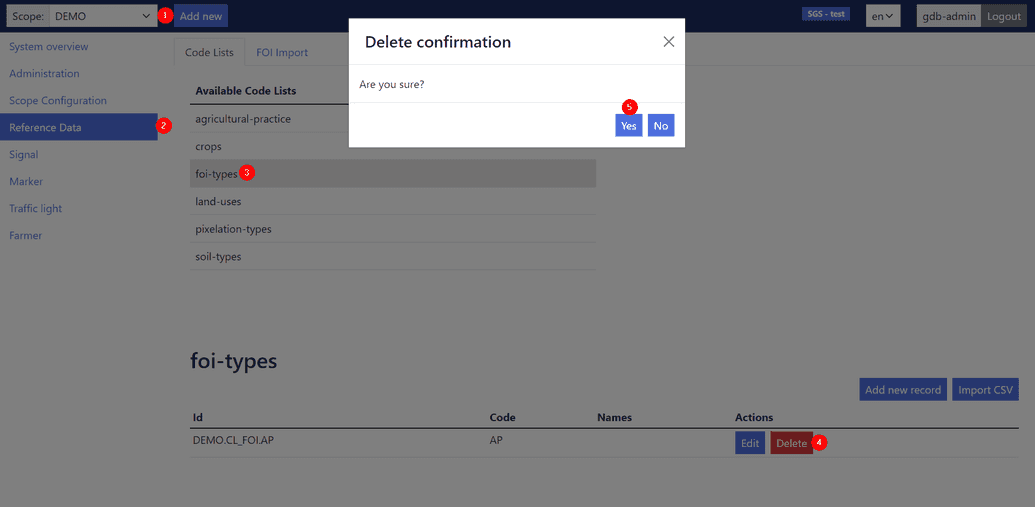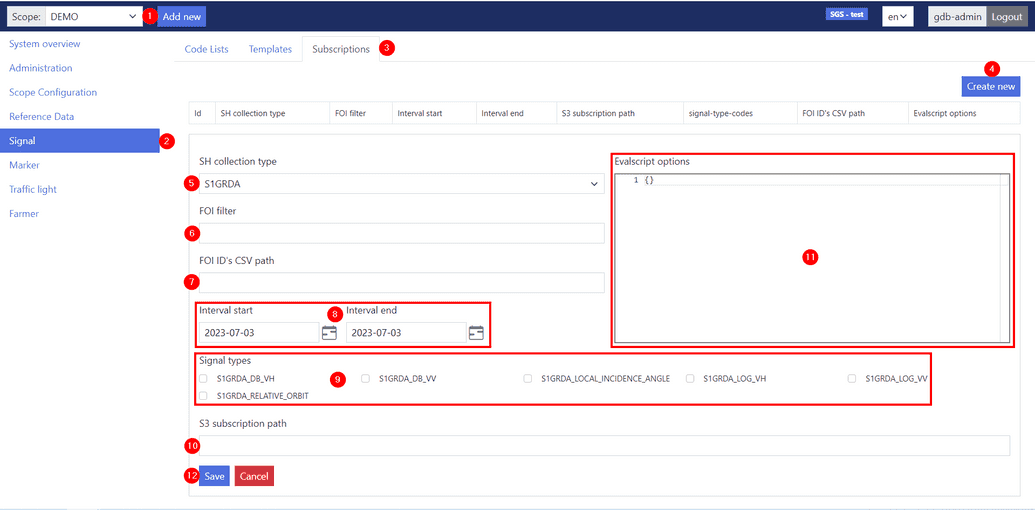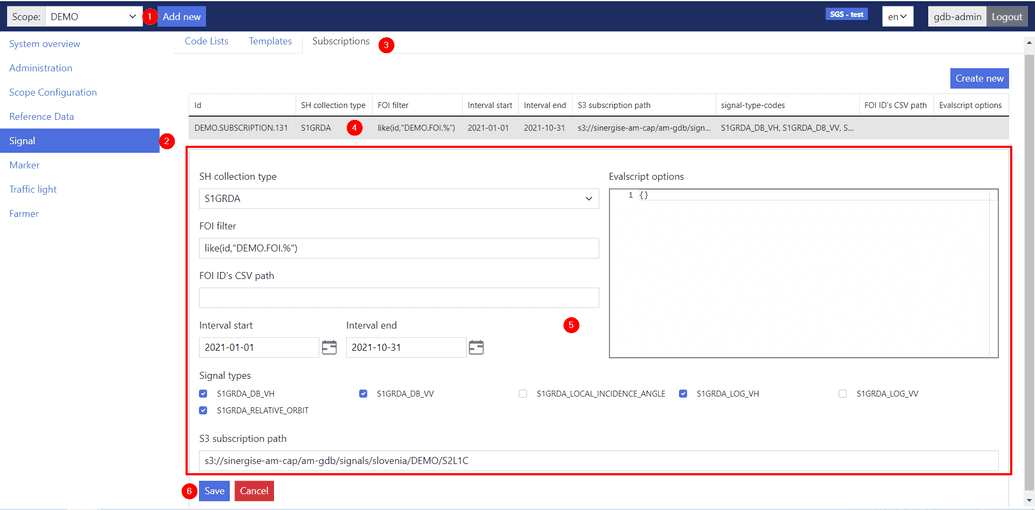Admin Application
Overview
The Admin Application provides a centralized place to:
- check the status of the area monitoring system
- create and configure scopes
- configure area monitoring system components (i.e. the reference data, the signals, the markers and the traffic light system) for a specific scope.
Therefore, this user guide assumes that:
- you have a solid understanding of the Area Monitoring.
- you have been granted access to the Admin Application.
Once you are logged in you will see the below user interface.
The Admin Application user interface consists of the following components:
| Name | Description |
|---|---|
| Drop-down arrow next to the Scope | Allows you to view a list of scopes you have access to. Selecting a scope will expose the conditional sections. |
| Add new button | Allows you to create a scope. |
| System overview section | Shows the following details about the services that are part of Area Monitoring applications: service name, base URL, version information, build information, API documentation presented as a hyperlink and status information. |
| Administration section | Allows you to: - provide the credentials that will be used to access to the secured S3 bucket that you created - provide the Sentinel Hub Client ID and Client Secret - manage the configurations of different applications and services. |
| Scope Configuration section | Shows details about the selected scope. |
| Reference Data section | Allows you to manage the Code lists listed in this section and to import the reference data. |
| Signal section | Allows you to manage the Code lists listed in this section and to configure the subscriptions for signals retrieval. |
| Marker section | Allows you to manage the Code list listed in this section. |
| Traffic light section | Allows you to manage the Code lists listed in this section. |
Create a scope
Click Add new.
In the Scope field, enter the scope ID.
The entered scope ID should match the scope specified in the GeoPackage file from which you will import the reference data.
In the SRID field, enter the SRID (spatial reference identifier) data, which is an EPSG code.
The entered EPSG code should match the EPSG code specified in the GeoPackage file from which you will import the reference data.
Click Create.
Credentials
This feature enables you to provide:
- the S3 credentials that will be used to access the bucket that you created
- the Sentinel Hub Client ID and Client Secret.
Get your Sentinel Hub Client ID and Client Secret. For more information about how to get your Sentinel Hub Client ID and Client Secret please check this instructions or this part of the tutorial video.
Select the appropriate Scope.
Go to the Administration section.
Go to the Credentials tab.
Enter the S3 bucket credentials, the Sentinel Hub Client ID and Client Secret in JSON format.
Click Save.
Configuration
This feature enables you to create and edit the configurations of different applications and services.
Create a configuration
- Select the appropriate Scope.
- Go to the Administration section.
- Go to the Configuration tab.
- Click Create.
- In the Key field, enter a key.
- Choose a content type from the drop-down menu.
- In the Validator field, specify a validator.
- Enter the configuration data.
- Click Save.
Edit a configuration
- Select the appropriate Scope.
- Go to the Administration section.
- Go to the Configuration tab.
- Click on the details of the desired configuration.
- Edit any of the other editable fields that display. See Create a configuration for an explanation of the fields.
- Click Save.
Code lists
Managing Code lists include actions such as adding records to a Code List, modifying the record details and deleting records from a Code List.
Add code list records
You can add records to a Code list using:
Add a code list record using JSON
- Select the appropriate Scope.
- Go to the Reference Data | Signal | Marker | Traffic light section.
- In the Code Lists tab, click on the desired Code list title.
- Click Add new record.
- Enter the record data in JSON format and click Add.
Note that a JSON key represents a header row value in a CSV file (see Add code list records using a CSV file for more details).
Add code list records using templates
In the sections Signal and Marker you can use templates to populate in bulk the records of the Code lists with data from predifined Code list templates for each Sentinel Hub (SH) collection.
Any template from the Signal section populates the following dependent Code lists:
sh-collection-typeslisted in Code Lists tab from the Signal sectionsignal-typeslisted in Code Lists tab from the Signal sectionpixelation-typeslisted in the Code Lists tab from the Reference Data section.Any template from the Marker section populates the
marker-typesCode list listed in the Code Lists tab from this section.
Select the appropriate Scope.
Go to the Signal | Marker section.
Go to the Templates tab.
Choose a collection from the drop-down menu.
In the drop-down menu from the Signal section are listed the collections types which are not included in the
sh-collection-typesCode list.In the drop-down menu from the Marker section will be listed the collections which are included in the
sh-collection-typesCode list.In the SentinelHub collection source field, enter the BYOC collection source if this was not auto-populated.
Click Add.
Add code list records using a CSV file
You can use a comma-separated values (CSV) file that contains information about the new Code list records you want to create in bulk.
Note that we recommend this method for adding records for the following code lists:
crops,agricultural-practice,foi-types,land-uses,schemes,soil-types,traffic-light-colours,decisions,event-types,judgement-reasonsandlanes.
- Select the appropriate Scope.
- Go to the Reference Data | Signal | Marker | Traffic light section.
- In the Code Lists tab, click on the desired Code list title.
- Click Import CSV.
- In the Select CSV file pop-up window, click Browse, choose the CSV file and click Import.
To successfully import a CSV, the content must adhere to these rules:
- The CSV file must consist of a header row that names the columns and multiple rows of values that are separated by semicolons (;) (or other characters).
- Each row of values is a Code list record.
- Header row values must match the field values listed in the below CSV file requirements that are provided for the Code lists for which the recommended method to add records is via a CSV file.
- Header row values are not required to be in the order listed, just make sure that the column header is over the appropriate information in each respective column.
The CSV file requirements for the code lists for which the recommended method to add records is via a CSV file:
| Field | Data type | Required | Description | Code List |
|---|---|---|---|---|
code | string | YES | Record's short unique code (use uppercase letters [A-Z], numbers [0-9], _, -) | crops, agricultural-practice, foi-types, land-uses, schemes, soil-types, traffic-light-colours, decisions, event-types, judgement-reasons, lanes |
names.<language> | string | NO | - Record's long name in given language - Change <language> in field name with appropriate ISO 639 Language ID (e.g. names.en)- You can add names fields for several different languages (e.g. names.en, names.sl). | crops, agricultural-practice, foi-types, land-uses, schemes, soil-types, traffic-light-colours, decisions, event-types, judgement-reasons, lanes |
status | string | YES | Record's status (usually ACTIVE but can be HISTORIC). | crops, agricultural-practice, foi-types, land-uses, schemes, soil-types, traffic-light-colours, decisions, event-types, judgement-reasons, lanes |
scope | string | YES | Scope ID of the scope to which the Code list belongs. | crops, agricultural-practice, foi-types, land-uses, schemes, soil-types, traffic-light-colours, decisions, event-types, judgement-reasons, lanes |
has_financial_impact | bool | YES | Record's financial impact (True or False) | schemes |
priority | int4 | YES | Traffic light colour priority (the default is 0 ) | traffic_light_colours |
For example the content of the CSV file to be used for adding records to the crops code list should look like this:
code;names.en;names.sl;status;scope
1;buckwheat;ajda;ACTIVE;DEMO
2;sugar beet;sladkorna pesa;ACTIVE;DEMO
Edit a Code list record
- Select the appropriate Scope.
- Go to the Reference Data | Signal | Marker | Traffic light section.
- In the Code Lists tab, click on the desired Code list title.
- Click the Edit button next to the record to be edited.
- Edit the JSON text and click Save.
Delete a Code list record
- Select the appropriate Scope.
- Go to the Reference Data | Signal | Marker | Traffic light section.
- In the Code Lists tab, click on the desired Code list title.
- Click the Delete button next to the record to be deleted.
- In the Delete confirmation pop-up window, click Save.
Import reference data from a GeoPackage file
This process assumes that:
- you have populated the appropriate Code lists from the Code Lists tab of the Reference Data section:
foi-types(mandatory)crops(mandatory if in the GeoPackage file is specified thecrop_code)land-uses(mandatory if in the GeoPackage file is specified theland_use_code)
- the GeoPackage adheres to the specifications
- you have uploaded the GeoPackage to a S3 bucket for which you provided the credentials.
- Select the appropriate Scope.
- Go to the Reference Data section.
- Go to the FOI Import tab.
- Choose a FOI type from the drop-down menu which lists the
foi-typesCode list records. - In the Geopackage path field enter the file’s S3 path.
- In the Geopackage FOI table name field enter the name of the GeoPackage table with the reference data to import.
- In Geopackage additional attributes field enter the name of the attribute specified in addition to the attributes from the GeoPackage specifications for the reference data. In case of multiple additional attributes, the names of the columns should be separated by a
,(comma) e.g. Att1, att2, etc. - Click Import.
Subscription
This feature enables you to specify the details required for retrieval of signals.
Create a subscription
This process assumes that:
- you have imported the reference data
- you have populated the Code lists from the Code Lists tab from the Signal section
- you have uploaded to the S3 bucket for which you provided the credentials the CSV file with the FOI IDs for which you want to retrieve SH collection signals
- the signals will be downloaded to the S3 bucket for which you provided the credentials .
Select the appropriate Scope.
Go to the Signal section.
Go to the Subscriptions tab.
Click Create new.
Select a SH collection type from the drop-down menu which lists the
sh-collection-typesCode list records.In FOI filter field enter the filter criteria if you want to retrieve SH collection signals only for the FOIs that match the entered criteria.
For the filter criteria refer to the API documentation for the
/refdata/{scope}/fois/searchAPI endpoint under thefoi-controllerresource that can be accessed from the API documentation hyperlink of theReference data serviceshown in the System overview section.In FOI ID's CSV path field enter the file’s S3 path with the FOI IDs for which you want to retrieve the SH collection signals.
Enter the time interval for which you want to retrieve the SH collection signals.
Select the checkbox next to the SH collection signals you want to compute.
In S3 subscription path field enter the S3 bucket path where will be downloaded to the retrieved signals.
Configure advanced evalscript options such as
mosaicking,custom datamasksandpreProcessScenes. For more information, see Sentinel HubClick Save.
Edit a subscription
- Select the appropriate Scope.
- Go to the Signal section.
- Go to the Subscriptions tab.
- Click on the details of the desired subscription.
- Edit any of the other editable fields that display. When changing the
Interval startandInterval endkeep in mind that subscriptions are only incremental in time. That means that if any signals were already downloaded (DONE signal packages exist) thatInterval startshould not be changed andInterval endcan only be incremented in time. See Create a subscription for an explanation of the fields. - Click Save.
